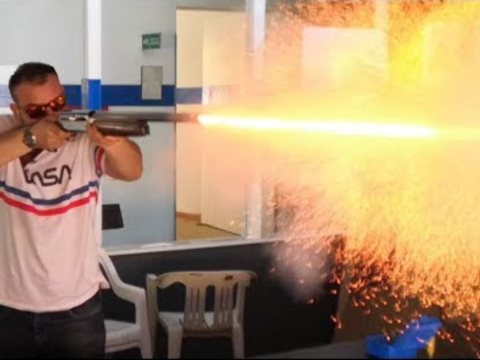The evolution from the traditional muzzleloader to the sophisticated modern firearm has been nothing short of remarkable. While technology has advanced significantly, certain aspects still maintain a fundamental connection to the roots of weaponry.
The intriguing question: which part of a modern firearm has the same function as the lock on a muzzleloader?
Table of Contents
Muzzleloaders and their Locks
To appreciate the parallels between muzzleloaders and modern firearms, it’s crucial to understand the historical context. Muzzleloaders, as the name suggests, were loaded through the muzzle (the open end of the gun barrel). These firearms, prevalent before the widespread adoption of breech-loading mechanisms, relied on a lock mechanism to ignite the gunpowder and propel the projectile.
The lock on a muzzleloader played a pivotal role in this process. Comprising various components such as the hammer, frizzen, and pan, it served as the ignition system. When the trigger was pulled, the hammer struck the frieze, creating a spark that ignited the gunpowder in the pan, ultimately firing the weapon.
Muzzleloaders to Modern Firearms
Fast forward to the present day, and we find ourselves in a world dominated by sleek, efficient, and highly engineered firearms. But despite the technological leaps, there remains a crucial component that mirrors the function of the lock on a muzzleloader.
The Firing Pin
In the realm of modern firearms, the firing pin takes on the role analogous to that of the lock on a muzzleloader. This small yet critical component is responsible for initiating the firing sequence. As we explore the functions and mechanisms, it becomes evident that the firing pin shares a common purpose with the lock of a muzzleloader.
Anatomy of the Firing Pin
1. Striking Mechanism
Similar to the hammer in a muzzleloader’s lock, the firing pin is designed to strike another component, typically the primer in a cartridge. This impact generates the necessary force to ignite the primer, initiating the combustion of the gunpowder.
Transitioning from the historical context to the modern realm, it’s fascinating to witness how the fundamental concept of striking a surface to create ignition persists.
2. Spring-Loaded Action
In both muzzleloaders and modern firearms, the mechanism is spring-loaded, ensuring a rapid and forceful strike. The energy stored in the spring is released upon pulling the trigger, propelling the firing pin forward with precision.
Picture the tension in the air as the spring compresses, ready to unleash controlled power—an evolution from the mechanical poetry of the muzzleloader’s lock.
3. Critical Timing
Timing is crucial in firearm operation. The firing pin must hit the primer at precisely the right moment to optimize the ignition process. This synchronization is reminiscent of the precise timing required in the lock of a muzzleloader for a successful shot.
From the precise choreography of the lock’s components in muzzleloaders to the synchronized dance of a modern firearm’s firing pin, the essence of timing remains constant.
Advancements in Modern Firearm Technology
While the firing pin embodies the historical legacy of the muzzleloader’s lock, it’s essential to acknowledge the technological strides that set modern firearms apart.
1. Electronic Firing Systems
In contemporary firearms, some cutting-edge models have embraced electronic firing systems. These systems replace the traditional firing pin with electronic components, offering enhanced control and customization. The transition from a mechanical firing pin to electronic innovation represents a quantum leap in firearm technology.
Witnessing the shift from traditional mechanics to electronic precision echoes the historical transition from muzzleloaders to modern firearms—a journey marked by innovation and adaptation.
2. Integrated Safety Features
Modern firearms often come equipped with advanced safety features, ensuring secure handling and preventing accidental discharges. The integration of these safety mechanisms reflects the commitment to responsible firearm use—a far cry from the simplicity of early muzzleloaders.
In the evolving landscape of firearm safety, today’s innovations draw a stark contrast to the inherent risks associated with the lock and ignition systems of muzzleloaders.
Anecdotes from the Arsenal
Adding a personal touch to this exploration, we draw from anecdotes of firearm enthusiasts who have seamlessly transitioned between muzzleloaders and modern firearms.
John’s Tale of Two Triggers
John, an avid shooter and history enthusiast, shares his journey from mastering the intricacies of a muzzleloader’s lock to seamlessly adapting to the nuanced triggers of modern firearms. “There’s a poetic connection between the two,” he muses, “the satisfaction of a well-timed shot transcends the eras.”
John’s narrative reflects the sentiment of many enthusiasts who find a profound connection between the historical charm of muzzleloaders and the refined triggers of modern firearms.
Emily’s Precision Shots
Emily, a competitive shooter, emphasizes the role of precision in her marksmanship journey. “Whether it’s the lock on my muzzleloader or the firing pin in my competition pistol, it’s all about hitting the mark with precision. The technology may have evolved, but the essence remains unchanged.”
Emily’s story underscores the timeless pursuit of precision, a pursuit that echoes through the ages from the lock of a muzzleloader to the high-tech firing pins of today.
Navigating the Landscape: A Buyer’s Guide
For those considering the purchase of a modern firearm, understanding the role of the firing pin and its historical connection to the muzzleloader’s lock can be enlightening. Here’s a step-by-step guide to aid prospective buyers:
1. Research the Firing Mechanism
Begin your journey by delving into the specifics of the firearm’s firing mechanism. Understand whether it employs a traditional firing pin or if it embraces electronic innovations. This knowledge forms the foundation of your understanding of the weapon’s ignition system.
Before making a purchase, arm yourself with knowledge about the firing mechanism, ensuring you choose a firearm that aligns with your preferences and shooting style.
2. Consider Safety Features
Evaluate the integrated safety features of the firearm. Modern advancements provide an array of safety mechanisms, from drop safeties to trigger safeties. These features contribute to a secure shooting experience, a far cry from the safety considerations associated with early muzzleloaders.
Prioritize safety in your selection process, appreciating the advancements that modern firearms offer in contrast to the historical nuances of muzzleloader safety.
3. Test the Trigger
Much like the lock on a muzzleloader, the trigger of a modern firearm plays a crucial role in the shooting experience. Visit a reputable firearm dealer or shooting range to test the trigger’s responsiveness and find a model that aligns with your preferences.
Don’t underestimate the significance of the trigger—the modern equivalent of the lock on a muzzleloader. A responsive trigger enhances your overall shooting experience.
Making the Choice
In conclusion, the journey from the lock on a muzzleloader to the firing pin of a modern firearm is a testament to the timeless principles of firearm operation. The transition reflects not only technological progress but also the unwavering pursuit of precision and safety.
As you embark on your journey into the world of modern firearms, armed with the knowledge of the firing pin’s pivotal role, consider the historical echoes and the personal anecdotes that weave through the tapestry of firearm evolution. Whether you’re a seasoned enthusiast or a first-time buyer, the connection between past and present adds depth to the experience.
Frequently Asked Questions (FAQs) related to the article:
1. What is the historical significance of the lock on a muzzleloader?
The lock on a muzzleloader played a crucial role in firearm history, serving as the ignition system for these early weapons. It comprised components like the hammer and frizzen, initiating the firing sequence when the trigger was pulled.
2. How does the firing pin in modern firearms compare to the lock on a muzzleloader?
The firing pin in modern firearms serves a function similar to the lock on a muzzleloader. It strikes a primer, initiating the ignition process. The evolution maintains the concept of controlled striking for ignition but with technological advancements for efficiency.
3. What are some safety features in modern firearms that differ from muzzleloaders?
Modern firearms boast advanced safety features, including drop safeties and trigger safeties. These mechanisms enhance the overall safety of the firearm, a stark departure from the simpler safety considerations associated with muzzleloaders.
4. How has technology influenced the firing mechanisms of modern firearms?
Technology has led to electronic firing systems in some modern firearms, replacing traditional firing pins. This innovation allows for enhanced control and customization, marking a significant departure from the mechanical firing pins of earlier firearms.
5. Why is understanding the firing mechanism crucial when purchasing a modern firearm?
The firing mechanism is at the core of a firearm’s operation. Understanding whether a firearm uses a traditional firing pin or embraces electronic innovations helps buyers make informed decisions based on their preferences and shooting style. It ensures compatibility with the user’s needs and expectations.






